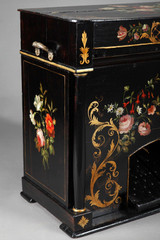Wooden bellows salon harmonium, raised on a small quadripod platform with a cut-out opening in the front to accommodate the pedalboard. Rich polychrome and gold decoration of bouquets of flowers and foliage on a black background. This antique musical instrument features two gilded bronze side handles. Keyboard flap in two hinged sections. Typical Napoleon 3 work. This instrument most probably came from a private collection (bourgeois house, château...) in the 1860-1870s. It is remarkable for its meticulous decoration. At the time, it was used to accompany voices or instruments (violin, for example). The instrumental part has only one obbligato register, in guide-song style. Condition report In good overall condition, with slight wear to the gilding, a few scratches from use and cracks in the wood. Several keys on the keyboard are depressed. The musical part can be restored by Jean-Jacques MOUNIER, Master Organbuilder, at a cost of 3,800 Euros, all taxes included. Following this work, it will be pleasant to hear and play, and will represent a rare and sought-after collector's item. Documentation The harmonium is a reed organ vibrated by air blown through bellows. The bellows on this upright harmonium are operated by pedals. The harmonium, derived from Grenié's expressive organ, was invented in Europe by the Frenchman Alexandre-François Debain (1809-1877), who patented it in 1842. In the 19th century, harmoniums were particularly popular in small churches and chapels, but could also be found in the homes of the aristocracy and upper middle classes. Napoleon III period, Circa: 1860 Dim: W:87cm, D:40cm, H:71cm.
- Reference :
- 2447
- Availability :
- Sold
- Width :
- 87 (cm)
- Height :
- 71 (cm)
- Depth :
- 40 (cm)
- Identifier Exists:
- False



















